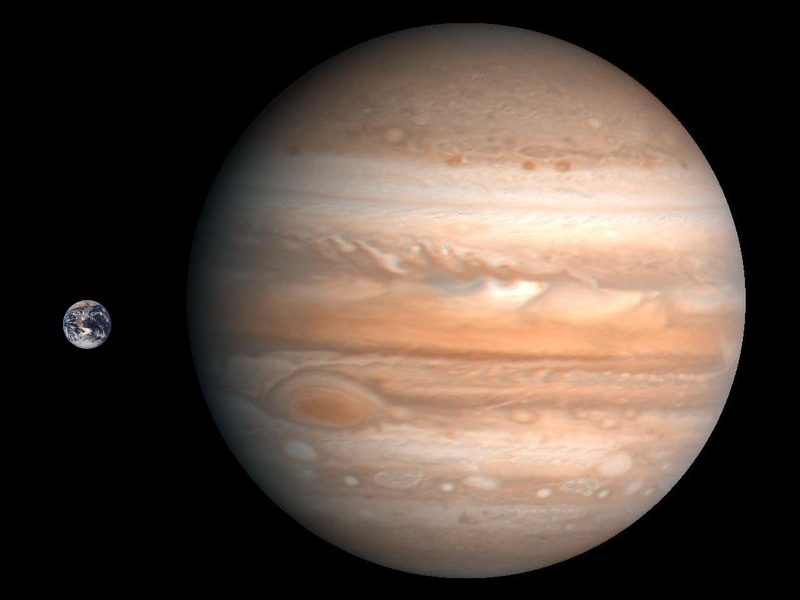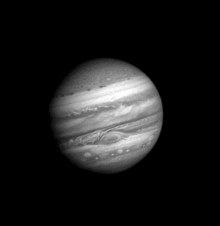Jupiter
Episode #5 of the course Introduction to the Solar System
Beyond Mars and just past the asteroid belt sits Jupiter, the fifth planet from the Sun—one of only five planets that can be seen without technical assistance and one of the four gas giants in our solar system. With a diameter of 86,882 miles (69,911 km), Jupiter is the biggest planet. In fact, Jupiter is 10,000 miles (16,093 km) larger than the next largest planet, Saturn, and it is 11.2 times wider than Earth.

Size comparison of Jupiter and Earth
A map of the solar system shows that Mercury, Venus, Earth, and Mars are all relatively close together (within 150 million miles (241 million kilometers) of the Sun), but not Jupiter. Jupiter is far from this primary planetary cluster—nearly 300 million miles (482 million km) away, to be exact. At its closest proximity, Jupiter is 460 million miles (741 million km) from the Sun, which is still five times farther than the Earth. This large distance means that Jupiter takes 12 Earth years to orbit the Sun, as the orbital path is much longer. Given that Jupiter has a much faster rotation speed, day lengths are much shorter and clock in at only 9 hours and 56 minutes.

Animation of Jupiter’s and Earth’s revolution around the Sun
Jupiter is sometimes referred to as the “gassy planet,” and along with Saturn, it is one of four gas giants in the solar system. The planet itself is composed primarily of thick layers of gas made of approximately 90% hydrogen and 10% helium. As a result, landing on the planet is of course out of the question. For the sake of scientific studies, scientists refer to the surface of Jupiter as the place where the atmospheric pressure is at an equivalent to that of Earth’s.
Jupiter is home to fast-moving storms, which can grow to cover massive areas up to thousands of miles wide within just a few hours. Lightning and damaging winds sweep across the planet and are produced by moist convection currents.

This view of Jupiter’s Great Red Spot (a giant storm that is known to have existed since at least the 17th century) and its surroundings was obtained by Voyager 1 on February 25, 1979, when the spacecraft was 9.2 million km (5.7 million miles) from Jupiter

Time-lapse sequence from the approach of Voyager 1 to Jupiter, showing the motion of atmospheric bands, and circulation of the Great Red Spot. NASA image.
While the discovery of most planets in our solar system is associated with an individual or team of scientists, nobody has claimed Jupiter’s discovery. We do know, however, that the Romans were the first to give Jupiter a formal name. The planet is named after the Roman god of the sky, thunder, and lightning. Historians also believe that Galileo Galilei was the first person to view Jupiter through a telescope, which is when he discovered four moons surrounding the planet. These moons are named Io, Europa, Ganymede (the largest known moon in our solar system), and Callisto and are sometimes referred to as the Galilean Moons. What Galileo could not see is that Jupiter in fact has 67 known moons, the latest of which was discovered in 2011.

The Galilean moons Io, Europa, Ganymede, Callisto (in order of increasing distance from Jupiter)
Recommended book
“A Brief History of Time” by Stephen Hawking
Share with friends

